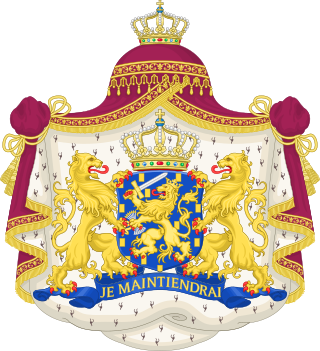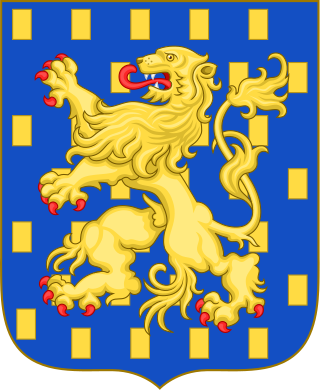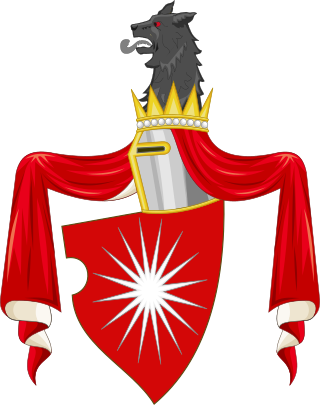Related Research Articles

The House of Orange-Nassau is the current reigning house of the Netherlands. A branch of the European House of Nassau, the house has played a central role in the politics and government of the Netherlands and elsewhere in Europe, particularly since William the Silent organised the Dutch Revolt against Spanish rule, which after the Eighty Years' War (1568–1648) led to an independent Dutch state. William III of Orange led the resistance of the Netherlands and Europe to Louis XIV of France and orchestrated the Glorious Revolution in England that established parliamentary rule. Similarly, Queen Wilhelmina of the Netherlands was instrumental in the Dutch resistance during World War II.

Prince of Orange is a title associated with the sovereign Principality of Orange, in what is now southern France and subsequently held by the stadtholders of, and then the heirs apparent of, the Netherlands.

René of Chalon, also known as Renatus of Chalon, was a Prince of Orange and stadtholder of Holland, Zeeland, Utrecht and Gelre.

This is a list of the Lords, Barons and Marquisses of Baux.

The Principality of Orange was, from 1163 to 1713, a feudal state in Provence, in the south of modern-day France, on the east bank of the river Rhone, north of the city of Avignon, and surrounded by the independent papal state of Comtat Venaissin.

The House of Nassau is a diversified aristocratic dynasty in Europe. It is named after the lordship associated with Nassau Castle, located in present-day Nassau, Rhineland-Palatinate, Germany. With the fall of the Hohenstaufen in the first half of the 13th century royal power within Franconia evaporated and the former stem duchy fragmented into separate independent states. Nassau emerged as one of those independent states as part of the Holy Roman Empire. The lords of Nassau were originally titled "Count of Nassau", subject only to the Emperor, and then elevated to the princely class as "Princely Counts". Early on they divided into two main branches: the elder (Walramian) branch, that gave rise to the German king Adolf, and the younger (Ottonian) branch, that gave rise to the Princes of Orange and the monarchs of the Netherlands.
James of Baux or James of Les Baux was the Latin Emperor of Constantinople from 1374 to 1383. He was the last Latin emperor to govern any imperial territory.

The House of Baux is a French noble family from the south of France. It was one of the richest and most powerful families of medieval Provence, known as the 'Race d’Aiglon'. They were independent lords as castellans of Les Baux and Arles and wielded very considerable authority at the local level. They held important fiefs and vast lands, including the principality of Orange.

The Anscarids or the House of Ivrea were a medieval dynasty of Burgundian and Frankish origin which rose to prominence in Northern Italy in the tenth century, briefly holding the Italian throne. The main branch ruled the County of Burgundy from the eleventh to fourteenth centuries and it was one of their members who first declared himself a count palatine. The cadet Castilian branch of Ivrea ruled the Kingdom of Galicia from 1111 and the Kingdoms of Castile and León from 1126 until 1369. The Spanish House of Trastámara, which ruled in Castile, Aragon, Naples, and Navarre at various points between the late 14th and early 16th centuries, was an illegitimate cadet branch of that family.
John IV was a Count of Armagnac, Fézensac, and Rodez from 1418 to 1450. He was involved in the intrigues related to the Hundred Years' War and in conflicts against the King of France.

Arlay is a commune in the Jura department in the region of Bourgogne-Franche-Comté in eastern France. On 1 January 2016, the former commune of Saint-Germain-lès-Arlay was merged into Arlay.

Chalon-Arlay was a noble house of the Holy Roman Empire. They were the lords of Arlay in the county of Burgundy and a cadet branch of the ruling house of the county, the House of Ivrea. The founder of the house was John I of Chalon-Arlay, fifth son of John, Count of Chalon. When John III, lord of Arlay, married Mary de Baux, princess of Orange, the House acquired the principality of Orange.

John II, lord of Chalon-Arlay was a member of the House of Chalon-Arlay. He succeeded his father Hugh I lord of Arlay to this title, and was himself succeeded by his son, Hugh II lord of Arlay.

John IV of Chalon-Arlay or John of Chalon was a prince of Orange and lord of Arlay. He played an important role in the Mad War, a series of conflicts in which aristocrats sought to resist the expansion and centralisation of power under the French monarch.

Louis II of Chalon-Arlay, nicknamed the Good, was Lord of Arlay and Arguel Prince of Orange. He was the son of John III of Chalon-Arlay and his wife, Mary of Baux-Orange, and the father of William VII of Chalon-Arlay.

John III of Chalon-Arlay was a French nobleman and a member of the House of Chalon-Arlay. He was the son of Louis I lord of Arguel, and the heir of his uncle, Louis's brother, Hugh II lord of Arlay from whom he inherited Arlay.
Margaret of Baux was a Countess of Saint-Pol, of Brienne, and of Conversano. She was a member of the noble House of Baux of the Kingdom of Naples, which had its origins in Provence dating back to the 11th century. Her husband was Peter of Luxembourg, Count of Saint-Pol, of Brienne, and of Conversano.

Amadeus III was the Count of Geneva from 1320 until his death. He ruled the Genevois, but not the city of Geneva proper, and it was during his time that the term "Genevois" came to be used as it is today. He was the eldest son and successor of William III and Agnes, daughter of Amadeus V of Savoy. He played a major rôle in the politics of the House of Savoy, serving consecutively as regent and president of the council, and also sitting on the feudal tribunal—one of three tribunals of the Audiences générales—of the Duchy of Aosta.

Louis I of Chalon-Arlay (1337–1366) was the second son of John II lord of Arlay and Margaret of Male.
William III of Geneva was the Count of Geneva from 1308 to 1320. He was the son of count Amadeus II of Geneva, and Agnès, daughter of John, Count of Chalon.
References
- 1 2 3 Josso 2003, p. 374.
- ↑ Barbey, Frédéric (1926). "Louis de Chalon, prince d'Orange, seigneur d'Orbe, Êchllens, Grandson 1390-1463" . Retrieved 11 August 2016.